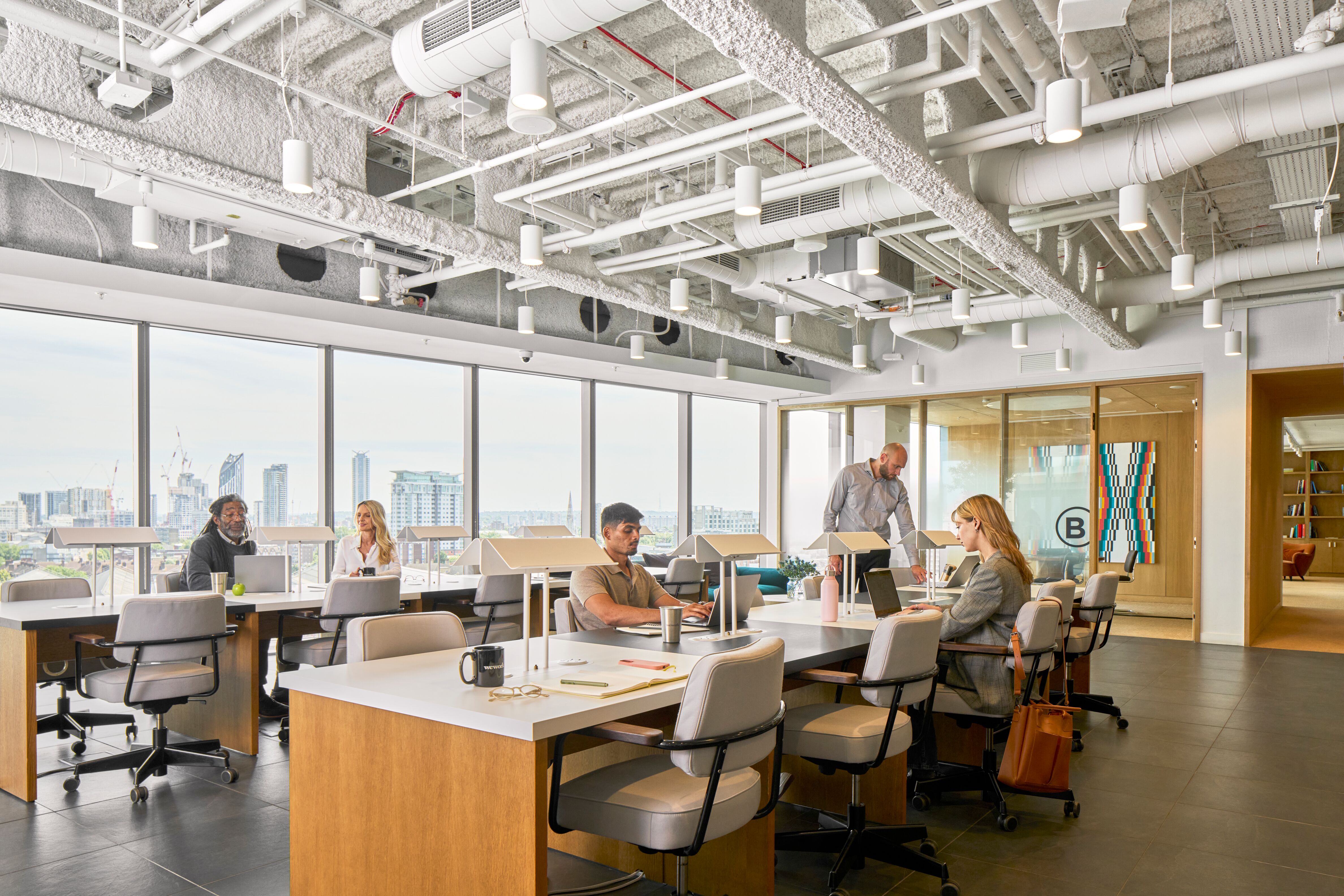The hybrid workplace model is a type of work environment that combines aspects of remote working and in-office working. In a typical hybrid workplace, some or all employees have the freedom to choose where and when they work, dividing their time between working from home and working from a central office.
A company using a hybrid working model can have one or more offices where a portion of their workforce regularly attends, while the remaining employees work remotely or from home. This is in contrast to a fully remote model of working, in which there are no physical premises and all employees work remotely.
How a hybrid environment operates depends on the company, but it could include a handful of employees who are permanently on-site, or several teams who operate on staggered schedules, swapping in and out every couple of weeks. A hybrid workplace might be almost entirely remote, with employees turning up to attend regular face-to-face meetings. Or it could be almost entirely office-based, with just a handful of workers or teams working remotely.
Whatever way it is organized, the goal of a hybrid workplace is to balance the needs of individual workers with their ability to collaborate and be productive in a shared physical space. In this article, we’ll take a look at the advantages of a hybrid workplace, why more companies are moving toward this way of working, and discuss some basic tips on implementing a hybrid model for your company.
Why more companies are turning to the hybrid workplace model
Since the COVID-19 pandemic upended the way we work, businesses have been forced to rethink what it means to have a physical workplace. Employee priorities have evolved over the past year. Some of us are reluctant to return to the office, while many simply can’t wait to get back. Most agree that the tradition of clocking in for a 9-to-5 shift is a relic of the past and that a more flexible approach needs to be taken.
The past year has proven that we have the tools, software, and skills to work effectively wherever we are, but it’s also highlighted the downsides of remote working. Employees can feel isolated or overlooked. Their tech setup at home may be lacking, or their workspace could be cramped or filled with distractions.
The gradual return to the office will be shaped by the lessons of this forced period of working from home. Employees want to choose where and when they work. They want to avoid busy commutes and spend more time with family and friends. They also want to see colleagues in person, and work together toward shared objectives in a physical space that isn’t their hastily repurposed dining table.

All of these factors have given rise to the hybrid workplace, a blend of remote and office working that aims to decouple the company from its physical headquarters, while still giving employees the freedom to work there if they choose.
For employers, the hybrid workplace is an opportunity to reshape existing office layouts, attract new talent from further afield, and increase the diversity of the workforce. Companies have also seen the positive impact remote working has had on employee satisfaction and productivity. The hybrid environment is a way to retain that positive impact over the long term.
Why employees prefer the hybrid workplace
Even before the pandemic hit, employees increasingly valued flexibility in the workplace. Having the freedom to choose where and when they work is more important than salary for nine out of 10 millennials. This reflects an evolving attitude of how we think about work and where it gets done, but the trend changes course when you survey younger employees.
It won’t be long before Gen Z is the dominant segment of the working population. In a 2020 Salesforce survey, this group expressed a growing desire not to work solely from home, but to split their working time between home and the office. For a worker at the very start of their career, the office is more valued, not less. It’s seen as a place to socialize, network, and collaborate. Being able to choose how often to be in the office is still important, but data suggests that Gen Z is less interested in working from home than their millennial colleagues.
This shift in preference toward the hybrid workplace and away from fully remote working can be explained by a few factors. On average, we’re each better equipped to work from anywhere there’s a power outlet and a decent Wi-Fi connection. Cloud-based software has made collaboration possible and reliable over any distance. And we increasingly pay attention to our work-life balance, shaping our professional schedules to fit around our personal lives, rather than the other way around.
But for some workers, the ability to work entirely from home can be constrained by their individual circumstances. Younger employees are less likely to have the space at home to set up a comfortable office, or they may still live with their parents or with roommates. They especially value face-to-face time with colleagues to help them build relationships, learn new skills, and access mentoring.
In a hybrid environment, the benefits of flexible working sit alongside the benefits of having a physical headquarters. The pandemic accelerated an existing trend, proving that a distributed workforce is possible, but it also highlighted some of the shortcomings of a purely remote working model. Employees—especially those just starting out—now want the best of both worlds.
How you can successfully implement a hybrid workplace
Transitioning to a hybrid workplace means rewiring your company’s processes from the inside out, making sure they work regardless of where they’re being utilized. It’s one of the toughest challenges a business can undertake, and how you approach that challenge depends on the size and shape of your business.
Take a look at how companies similar to yours have moved to a hybrid or remote way of working, and pay attention to the lessons they learned—and the mistakes they made—along the way. To help you plan, here are a few general ideas to bear in mind.
Ask employees what they actually want
Don’t assume that all workers want the same thing. Everyone’s priorities are different, and implementing a successful hybrid workplace should involve the feedback of employees from every corner of the business. Survey your team and be responsive to their answers. Be realistic with them about the kinds of changes you can make to the workplace, and make yourself available to hear their concerns and requests.
Offer options, but not too many
Give employees a menu of two or three ways of working at your company: one that is mostly based in the office, one that is mostly working from home, and one that is somewhere in between. Let people change their preferences, but try to encourage them not to do this too frequently. This way you can plan ahead and have a firm idea of where everyone will be at any given time, allowing you to allocate resources more effectively.
Embrace technology
The same software that powers remote working is also at the heart of a smooth-functioning hybrid workplace. Take advantage of cloud-based productivity software and videoconferencing tools to create a level playing field between those who are working remotely and those who are in the office.

Ensure that everyone has access to the hardware they need to work remotely. Identify any day-to-day tasks that can only be completed at the office, consider why this might be, and then look for alternative solutions. A worker should be no less able to do their job when they’re not at the office. In the ideal hybrid workplace, a worker should be able to do their job even if the office vanished into thin air overnight.
They should also have access to any resources and information they need to be effective, so make these accessible and easy to reach. Document every last detail—from a client meeting to an informal chat in the corridor—so that every employee is up to date and on the same page.
Maintain your company’s culture
Culture is a tricky idea to pin down. A company can have a corporate philosophy or a set of guiding values, but the culture of a workplace arises organically out of interactions between workers. Keep remote employees tethered to the social side of the office with informal online meetups and virtual town halls, so that these proverbial watercooler moments aren’t missed.
Make sure remote colleagues feel they’re getting the complete employee experience. Review perks to ensure they’re not only benefiting those workers who come to the office. For example, if employees can enjoy unlimited coffee and snacks in the canteen, you might offer remote workers a free coffee subscription or perhaps free meal kits.
Translating in-person culture to a remote or hybrid one is an enormous challenge, and it doesn’t happen overnight. Begin by deciding what your company’s values are, put them in writing, and then reinforce them through every channel you can.
Make your job listings remote
The true test of a hybrid workplace is how you recruit new employees. Wherever you can, make job listings location-agnostic. Develop a new interview and hiring process that supports applicants no matter how far from the office they may be, and give them the resources and opportunities they need to travel to and from the office for meetings and social events.
Create a socially distanced office layout
With fewer people in the office, you can more easily implement a layout that’s optimized for employee safety. It’s unclear how long social distancing guidelines will last, so use this opportunity to de-densify the workplace and create shared coworking spaces around the office. Introduce plenty of personal space between workstations, and design one-way systems to lead employees safely around the building.

Don’t overlook who you can’t see
Remote workers are less visible than their in-office counterparts, which means they’re at greater risk of being overlooked for promotions and other opportunities. Be aware of this natural bias and take steps to ensure fairness and equality in your decision-making.
Train managers to support and include remote workers, and adapt your recruitment processes to create as level a playing field as possible, so that remote employees don’t find themselves at a professional disadvantage simply for not being in the room.
How WeWork can help you transition to a hybrid workplace
The core principles of the hybrid workplace empower employees to do their best work regardless of where they are. WeWork’s offices are designed around flexibility and can help you adopt a more dynamic way of working. Whether you’re planning to launch a satellite office for a remote team, or moving to a workspace that can quickly scale to meet the changing needs of your company, WeWork provides inspiring and adaptable workplaces that support your business goals.
Dedicated desks and private offices help remote workers feel more connected to their colleagues in the office. A distraction-free setting, modern meeting rooms, high-speed Wi-Fi, and business-class facilities give your team members the tools they need to stay productive, engaged, and collaborative, no matter the distance.
Products like WeWork All Access and WeWork On Demand offer even greater flexibility, granting you access to workspaces and meeting rooms in major cities around the world.
For a hybrid model to succeed, nobody can be left behind. A flexible workspace that responds to new strategies is an important part of the transition, and gives company leaders the peace of mind they need to make the right decisions for their employees. Changing the way your business operates is fraught with challenges, but the potential to realize a better work culture—one that’s sustainable, productive, and inclusive—is enormous.
Steve Hogarty is a writer and journalist based in London. He is the travel editor of City AM newspaper and the deputy editor of City AM Magazine, where his work focuses on technology, travel, and entertainment.
Rethinking your workspace?







